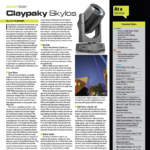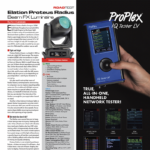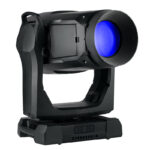DTS perhaps might not be familiar to many Americans, but the Italian company has been around since the 1980s when they started making domestic and commercial lighting and working with fiber optics. Today, they make a range of LED and arc-source fixtures for entertainment and architectural applications. The company’s WONDER.D enters the scene with a few tricks up its proverbial sleeve, including some unique and very interesting zoom effects.
The fixture follows the standard physical form for LED wash lights — a base and yoke with a large frying-pan shaped head. The unit’s head is quite deep to accommodate the aluminum heatsink as well as the optical system and separate zooms.
Light Source
On the fixture’s face are 49 Osram RGBW packages mounted on four circuit boards; three arc-shaped ones forming the outside circle, and one circular one at the center. These rest on a large aluminum heatsink that makes up the rear of the head, with four thermostatically-controlled fans for thermal management.
There is no lens on top of the square dies. Instead, each quad-color emitter is in direct contact with a long square light pipe to combine all the colors, each of which is topped with a small square output lens to help further homogenize the final mix. Above this, the final output lenses are mounted, in two separate sections for the individual zoom — the center lenses being markedly larger in diameter.
The dimming uses a single 8-bit channel, and DTS provides two dimmer curves: linear, and one they call “quadratic,” which looks very much like a theatrical S-curve (See Fig. 1). The quadratic curve responds the best in my opinion, though it exhibits some deceased control past 85 percent. On the linear setting, the fixture’s output snaps to full at around 70 percent on the dimmer channel. I would probably avoid the linear setting in favor of the smoother quadratic curve. DTS tells me they plan to address the dimmer curves in a future software update.
The default PWM frequency is 600Hz, and DTS provides the option through the menu system to select a variety of frequencies up to 20kHz, which is very fast and should prevent any issues with cameras. There is an inverse relationship between the PWM frequency and how many bits you can allocate to dimming — the result being that faster PWM frequencies result in noticeably more steppiness during fades. PWM frequency vs. dimming smoothness is always going to be a trade-off, so end users will have to experiment to decide what works best for their application. DTS provides a menu option to add a fade time to the LEDs to help smooth out the steps, adjustable from 0 to 250ms. This setting is global; it affects the dimming channel as well as the color channels. I noticed that the LED electronics have an audible electronic “whine” at certain PWM frequencies, which may be objectionable for some applications.
I measured output with all emitters at full immediately upon startup, and again after reaching thermal equilibrium, and read an output drop of 63 percent of initial levels, which fluctuated throughout testing.
Colors
Color mixing is as expected from RGBW systems. The blue is quite deep (460nm), so keep that in mind when mixing with other fixtures in your rig. The optical system does an excellent job of homogenizing and mixing the separate colors; I saw no multicolored shadows anywhere along the zoom range, even at extremely close distances. The output color shifts visibly red toward the bottom 50 percent of the dimming range, something to be aware of when mixing colors that include red. The white emitter is very useful for creating pastel shades and flesh tones, and mixed whites and lighter shades were overall very clean and usable.
As mentioned previously, the face of this fixture is divided into four sections, one center circular section surrounded by three arc-shaped 120° sections. These sections are controllable individually, which allows for some spectacular effects. The narrow range of the zoom projects a very nice defined beam in mid-air, especially effective when doing color chases and effects. The fixture also includes a CTC channel which smoothly adjusts the color temperature down to 2700 Kelvin. The output percentages of individual emitters added up to more then 100 percent, indicating some load-sharing going on among the various colors.
Zoom and Strobe
The fun, unexpected feature here is the two zoom sections. The outside “ring” and inside center section are on separate linear actuators, the outside featuring a zoom range of 8° to 52°, and the inside ranging from 3.5° to 52°. The outside zoom covers its range in 0.73 seconds, while the inside zoom takes 1.1 seconds. The center cluster provides a noticeable bright spot when on, particularly at narrow angles, and when off, the projected wash has a nice, smooth field. I was able to produce some very interesting effects by playing with the two zoom’s relative positions, applying effects, and adding in dimmer and color effects. Setting the center zoom to narrow and the outer ring to wide while in a darker color creates a particularly effective look.
There are two control modes, 34 and 38 channel. In the latter mode, each section has a individual shutter control, allowing full strobe control over each sector. The unit includes the full gamut of strobe effects, including pulses, random, and regular strobe up to a very fast 35hz.
Movement
 The WONDER.D has a pan range of 540° degrees in normal usage, and a tilt range of 270°, which is a standard range for moving lights of this type. A complete pan rotation takes approximately 3.1 seconds to complete, while a full tilt movement takes approximately 1.3 seconds. These are worst-case numbers; travel distances in real-world applications are likely to be much shorter. Additionally, the user can select a shortest-path algorithm via DMX. Another great feature here is what DTS calls FPR, or Free Pan Rotation: the unit can continuously pan, spinning endlessly to create a searchlight or police beacon effect. This can be varied down to approximately one revolution every two minutes.
The WONDER.D has a pan range of 540° degrees in normal usage, and a tilt range of 270°, which is a standard range for moving lights of this type. A complete pan rotation takes approximately 3.1 seconds to complete, while a full tilt movement takes approximately 1.3 seconds. These are worst-case numbers; travel distances in real-world applications are likely to be much shorter. Additionally, the user can select a shortest-path algorithm via DMX. Another great feature here is what DTS calls FPR, or Free Pan Rotation: the unit can continuously pan, spinning endlessly to create a searchlight or police beacon effect. This can be varied down to approximately one revolution every two minutes.
Homing the fixture from a cold start to final output look took 1:11 minutes. When resetting in a look, the fixture will begin outputting the dimmer and color information before the pan and tilt have reached their final position, something to be aware of when resetting during a show. DMX input is via three and five-pin connectors, and the unit also supports RDM. It also has an RJ-45 port for future Art-Net expansion, but at the moment this functionality is not available on the light. DMX addressing and various fixture settings are entered via a display on the side which is equipped with a battery for non-powered addressing and setting changes — a feature I greatly appreciate. Power is provided by Neutrik PowerCON in and throughs, and auto-ranges from 90-260VAC.
Most of the noise from the fixture comes from the four fans on the back of the head as they ramp up and down to keep the fixture cool. The zoom is also somewhat noisy, but I doubt this will be an issue for the WONDER.D’s intended users. For users who need to keep things quieter, there’s a “Studio mode” available in the menu options. This setting keeps the fans from running until they’re needed, and slows down the pan and tilt speed to help with noise levels, something theatrical or church users are likely to find useful.
The WONDER.D is an interesting offering with some interesting tricks, including the dual zoom sectors and continuous rotation, and shows that DTS is serious about increasing their presence in the U.S. and abroad.
At a Glance
Plenty of Twists and Tricks
DTS touts the smooth, even field of light that its DTS WONDER fixtures can produce, but for lighting designers looking for a variety of unusual and novel effects, the WONDER.D’s 49 LEDs can do much more. Along with the ability to control the LEDs in four separate sections, programmers and designers can leverage the fixture’s two zoom sections. Throw in the fixture’s free pan rotation, and the range of potential looks might set your head spinning.
WONDER.D
PROS: Continuous pan, dual zoom sectors
CONS: Dimming curve, red color shift
STATS
|
Size |
23.7 x 20.2 inches |
|
Weight |
51.6 lbs. |
|
LEDs |
49 RGBW |
|
Output |
22K Lux @ 5m |
|
Outer Zoom |
8° to 52° |
|
Inner Zoom |
3.5° to 52° |
|
Price (MSRP) |
Contact dealer |
|
More Info |



